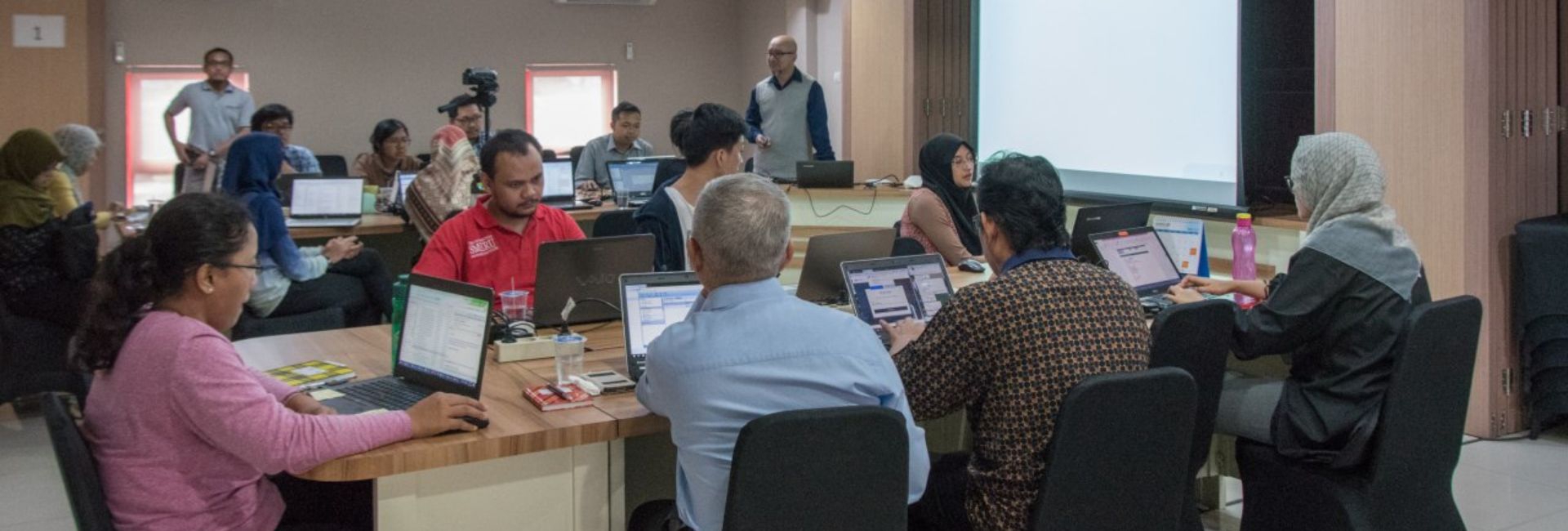.
The Indonesian version of this article was originally posted on the Knowledge Sector Initiative website and has been translated by the SMERU team.
.
The major agenda discussed during SMERU’s 2015–2019 Strategic Plan formulation process was the demand for SMERU to take necessary steps to be more professional and business-oriented to ensure its sustainability. The strategic plan clearly stated that SMERU needed to make improvements, which would be realized in five phases, starting in 2015 and continuing until 2019.
March 2014. The news finally broke! What we had been hearing as a mere rumor was now confirmed. In the middle of the organizational changes, The SMERU Research Institute received surprising news from the Knowledge Sector Initiative (KSI) concerning the cut in core funding from the Government of Australia. The change in the political direction in Australia led to some adjustments in its agenda to support Indonesia. Since 2010, the core funding had supported at least 50% of the total financing of SMERU, so “How will this place still be running if it loses 50% of its funding?” This question popped up in the minds of close to 60 staff members working at SMERU when the director, Dr. Asep Suryahadi, broke the news at one of the monthly staff meetings.
This development forced SMERU to rethink of its future, not only regarding its research programs, which had been its main product, but also how it could ensure the financial sustainability as an organization. It was clearly high time that it put to the fore efficiency and effectiveness in each financing line in the organization, including in human resource management. SMERU realized that financial sustainability was of utmost importance; however, SMERU should not stray from its focus and maintain its other main assets, namely the human resources. This became a strong resolution for the management of SMERU! Regarding the management of human resources, the management team, led by SMERU’s Director, realized that even though SMERU had its regulations concerning the employees—which stipulated the essential points regarding the rights and responsibilities of the staff, SMERU had not sufficiently placed the staff as one of the Institute’s pillars, which required better attention and should be supported with a more focused or targeted plan.
To respond to the concern about SMERU’s sustainability, in late 2014, SMERU held an annual strategic meeting to specifically discuss the organization’s plan for the next five years. KSI fully supported this five-year planning initiative. At first, SMERU selected three prospective consultants, and then proceeded to select Tjitra Consulting to help formulate SMERU’s 2015–2019 Strategic Plan. Led by Dr. Hora Tjitra, an academic and a national- and international-level management consultant, the independent consulting agency had a track record deemed ideal for what SMERU needed.
The major agenda discussed during the 2015–2019 Strategic Plan formulation process was the demand for SMERU to take necessary steps to be more professional and business-oriented to ensure its sustainability. The strategic plan clearly stated that SMERU needed to make improvements, which would be realized in five phases, starting in 2015 and continuing until 2019.
Urgent need to improve the quality of SMERU’s human resources
To achieve these improvements, at the initial stage, SMERU focused on growing the organization, including improving the system and strategies related to human resources. In terms of work process management, SMERU actually already had and followed the strict Standard Operating Procedure (SOP) for Personnel. Some adjustments, however, were necessary to meet the current needs, and it was important that all staff be aware of this. Moreover, SMERU’s analysis of the condition of the human resources showed that SMERU rarely conducted periodic dissemination and review of this ‘living document.’ SMERU was also driven to grow their staff’s capacity, so SMERU invested in more systematic and structured training programs to support the productivity of the organization. The management also improved the recruitment system, besides conducting evaluation of learning and development activities as part of the staff capacity development. However, SMERU still needed to define the competencies its staff need to have for each level of position and determine the right human resource development strategies per the needs of each staff to achieve the required competencies.
The need to improve human resource development became more urgent as in September 2015, one of the senior researchers, Dr. Syaikhu Usman, entered retirement. This was the first retirement that happened in the organization. There was no precedent or example of a person in SMERU entering their retirement age. How could SMERU capitalize on Dr. Usman’s knowledge and expertise? How would the organization transfer the accumulated knowledge the person of his caliber possessed to SMERU’s next generation of researchers? These were some of the points the management had not thought of before. Furthermore, the staff turnover rate in SMERU was high. In the 2014–2015 period, at least 15 people had resigned, citing several reasons, including continuing their studies.
Becoming more professional like a business organization
The management became aware that all this time the organization was strongly focused on research projects and acquirement of new sources of funding for the sustainability of the organization without really paying attention to matters related to staff—from recruitment, development, incentive and disincentive provision, layoffs, to retirement procedures.
Seeing the importance of improving the human resource management system, in late 2015, with a funding support from KSI, SMERU selected a human resource consultant that could help develop the organization’s human resource strategies. Through a selection process, PT. Bina Sarana Manusatama (BSM) was chosen, as it was deemed able to offer the needed solution, namely a comprehensive strategy which would support the organization to be more professional and business-oriented, as per the main agenda of the 2015–2019 Strategic Plan. In the process of formulating the human resource strategies, SMERU also benefited from the presence of the Business Development Staff from Australian Volunteers International (AVI), who helped make clearer various aspects of human resources as part of the process of developing an organization.
To become more professional like a business entity meant making changes to the current practices and culture in the organization. When there was a discussion about using a timesheet or attendance monitoring system to keep track of staff productivity, the topic did not receive a warm welcome and the staff argued that it could undermine the spirit of familiarity and kinship in the office. It is true that this spirit of kinship has forged a strong sense of belonging between the staff members. On the other hand, this led to a certain feeling of reluctance to bring up issues of low performance or to reprimand certain staff members for their low performance. Furthermore, ineffectiveness was tolerated. These sorts of behavior should be done away with.
The use of the online timesheet system was a breakthrough for SMERU in its bid to become a professional organization. The development of the timesheet system was expected to help SMERU to monitor the staff’s performance and accurately determine human resource funding for a certain research project. That way, the use of timesheet would indirectly support the financial sustainability of the organization. One of SMERU’s senior researchers, Rachma Nurbani, said, “Actual reports [on workhours], I believe, can show whether we are underutilized or overutilized at certain periods. Indirectly, this helps the organization in cost management, right?”
The formulation of the Human Resource Strategies was concluded and has been in the implementation stage. For instance, currently SMERU is in the process of reviewing and improving the SOP for Personnel, and it will be finalized in December 2016. SMERU is also making an improvement to the staff evaluation form and mechanism. Previously, staff members were evaluated based on the 360-degree evaluation system, namely by their superior and peers, both in the same division and from other divisions. This evaluation system is to be revised. Staff members will be evaluated by their direct superior who understands their scope of duty and workload through face-to-face discussions. With this new evaluation system, staff members have a bigger chance to discuss and receive input about their performance and capacity development.
All this time, the annual bonus was distributed evenly to all staff members regardless of their individual performance
SMERU is also evaluating its reward system for the staff. All this time, the annual bonus was rewarded to all staff without taking into consideration their individual performance. Going forward, SMERU is considering an annual bonus scheme based on individual performance. Hopefully, this will lead to healthy competition that can motivate the staff members to improve their productivity and performance, and ultimately, positively affect SMERU’s professionalism and quality of outputs.
Also, based on the Human Resource Strategies, SMERU has made adjustments to positions and career paths of 13 staff members in the management as well as the research and nonresearch departments. The director’s decision regarding researcher and nonresearcher career paths has proven that by giving a bigger responsibility, an individual could show better performance. At the management level, SMERU appointed a research coordinator working under Deputy Director of Research and Outreach. The research coordinator is responsible for overseeing every step of the research preparation and implementation; making sure that the quality assurance and control system is running; monitoring the report writing, completion, publication, and dissemination; and ensuring the accuracy in meeting the report deadline.
Having a research coordinator has been proven to be beneficial. The research coordinator helps the Deputy Director of Research and Outreach to monitor SMERU’s research. The coordinator submits a report at a monthly staff meeting and the reports have helped the management team, research staff, and support staff to comprehensively see all activities and stages of each research project.
In terms of capacity development, at present, there is a monthly internal seminar, both for the public and limited to SMERU staff. The event becomes a medium for a discussion, learning, and mentoring for the staff to accumulate institutional knowledge and to bridge the gaps in knowledge and field experience between the senior researchers, junior researchers, and new staff members. Furthermore, SMERU also holds thematic training for researchers/nonresearchers based on specific needs.
We are aware that any form of change in an organization cannot take place overnight. It requires commitment, funds, and a change in mindset and work culture, not only at the management level, but also for every staff member. SMERU will continuously strive to implement its Five-Year Strategic Plan in accordance with mutually agreed phases and schedules.
Transparent and accountable management, strong human resources, sustainable finance, and a strong sense of ownership are SMERU’s main pillars to continue to produce knowledge and accumulate institutional knowledge. We believe that by committing to these pillars, ultimately, we can secure fundings for our research projects, along with the growing trust from the public and stakeholders in The SMERU Research Institute’s performance.




